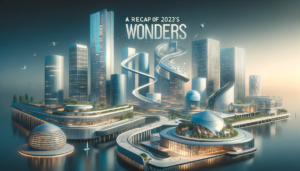As the technological landscape is expanding, a new frontier has emerged with it— the Metaverse. Far beyond a realm for gaming and entertainment, the Metaverse is becoming a virtual canvas where architects and designers are pioneering innovative approaches to spatial design. As we delve into this digital cosmos, let’s unravel the architectural phenomena shaping the Metaverse.
Metaverse Architecture:
Traditional architecture grounded itself in physical spaces, but the Metaverse introduces a paradigm shift. Here, architects are not bound by the laws of physics or the limitations of materials. Spaces can defy gravity, reshape instantly, and exist beyond the constraints of the tangible world. MetaArchitects, for instance, a collaborative group of architects within the Metaverse, presented Neon Horizon Plaza. This bustling digital metropolis defies the conventions of gravity and scale, creating a vibrant urban space where neon lights dance against a cosmic backdrop. It exemplifies the collaborative and dynamic nature of Metaverse architecture.
Architects are not just crafting visually stunning environments; they’re engineering experiences. The user’s journey through these digital spaces becomes a carefully orchestrated narrative, blending aesthetics with functionality to create immersive and engaging encounters.
Spatial Dynamics in the Virtual Realm
One of the many fascinating aspects of Metaverse architecture is the dynamic nature of space. Environments can evolve, responding to user interactions and real-time data. This dynamic spatial design introduces a level of adaptability and interactivity that transcends the static nature of traditional physical spaces.
It also goes without saying that the Metaverse is a collaborative space and is not solely shaped by architects; it’s an inclusive creation involving users, designers, and developers. Architects become facilitators of experiences, working hand-in-hand with diverse teams to bring digital environments to life. This collaborative approach sparks a fusion of creativity and technological expertise.
Augmented and Virtual Dimensions
Architects are also continuously exploring augmented and virtual dimensions to create layers of reality within the Metaverse. Augmented reality (AR) overlays digital elements onto the physical world, while virtual reality (VR) immerses users entirely in digital realms. This integration of realities opens new possibilities for architectural storytelling and user engagement.
Challenges and Ethical Considerations
As architects ventured into the Metaverse, ethical considerations come to the forefront. Issues of privacy, data security, and the potential for creating exclusive digital spaces raise important questions. Navigating these challenges will be crucial to ensuring the Metaverse becomes an inclusive and ethically designed environment.
The Future Beckons: Metaverse as a Design Playground
The Metaverse is not just a trend; it’s a glimpse into the future of architecture and design. As architects push the boundaries of the physical and embrace the digital, we find ourselves on the cusp of a design revolution. The Metaverse, with its infinite possibilities, invites architects to redefine space, challenge norms, and create experiences that transcend the limits of the tangible world.
With that said, it can be seen that the Metaverse, with its ever-expanding horizons, beckons architects to dream beyond the tangible, challenging them to redefine reality itself. As we witness these digital wonders, we find ourselves at the dawn of a new era—one where the boundaries between the physical and the digital blur, and architecture becomes a canvas for boundless imagination.







